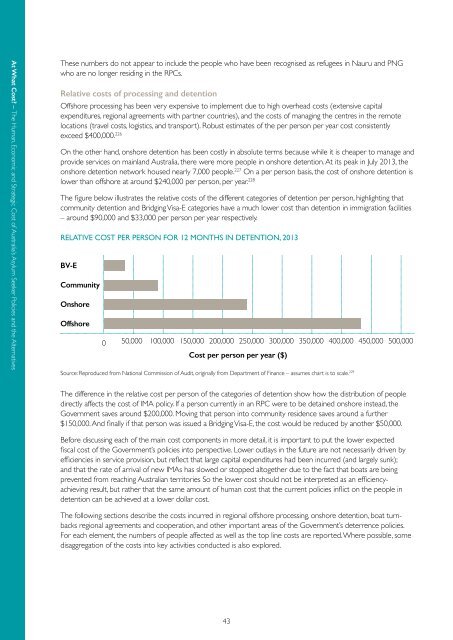AT WHAT COST?
At-What-Cost-Report-Sept-2016
At-What-Cost-Report-Sept-2016
You also want an ePaper? Increase the reach of your titles
YUMPU automatically turns print PDFs into web optimized ePapers that Google loves.
At What Cost? – The Human, Economic and Strategic Cost of Australia’s Asylum Seeker Policies and the Alternatives<br />
These numbers do not appear to include the people who have been recognised as refugees in Nauru and PNG<br />
who are no longer residing in the RPCs.<br />
Relative costs of processing and detention<br />
Offshore processing has been very expensive to implement due to high overhead costs (extensive capital<br />
expenditures, regional agreements with partner countries), and the costs of managing the centres in the remote<br />
locations (travel costs, logistics, and transport). Robust estimates of the per person per year cost consistently<br />
exceed $400,000. 226<br />
On the other hand, onshore detention has been costly in absolute terms because while it is cheaper to manage and<br />
provide services on mainland Australia, there were more people in onshore detention. At its peak in July 2013, the<br />
onshore detention network housed nearly 7,000 people. 227 On a per person basis, the cost of onshore detention is<br />
lower than offshore at around $240,000 per person, per year. 228<br />
The figure below illustrates the relative costs of the different categories of detention per person, highlighting that<br />
community detention and Bridging Visa-E categories have a much lower cost than detention in immigration facilities<br />
– around $90,000 and $33,000 per person per year respectively.<br />
REL<strong>AT</strong>IVE <strong>COST</strong> PER PERSON FOR 12 MONTHS IN DETENTION, 2013<br />
BV-E<br />
Community<br />
Onshore<br />
Offshore<br />
0<br />
50,000 100,000 150,000 200,000 250,000 300,000 350,000 400,000 450,000 500,000<br />
Cost per person per year ($)<br />
Source: Reproduced from National Commission of Audit, originally from Department of Finance – assumes chart is to scale. 229<br />
The difference in the relative cost per person of the categories of detention show how the distribution of people<br />
directly affects the cost of IMA policy. If a person currently in an RPC were to be detained onshore instead, the<br />
Government saves around $200,000. Moving that person into community residence saves around a further<br />
$150,000. And finally if that person was issued a Bridging Visa-E, the cost would be reduced by another $50,000.<br />
Before discussing each of the main cost components in more detail, it is important to put the lower expected<br />
fiscal cost of the Government’s policies into perspective. Lower outlays in the future are not necessarily driven by<br />
efficiencies in service provision, but reflect that large capital expenditures had been incurred (and largely sunk);<br />
and that the rate of arrival of new IMAs has slowed or stopped altogether due to the fact that boats are being<br />
prevented from reaching Australian territories So the lower cost should not be interpreted as an efficiencyachieving<br />
result, but rather that the same amount of human cost that the current policies inflict on the people in<br />
detention can be achieved at a lower dollar cost.<br />
The following sections describe the costs incurred in regional offshore processing, onshore detention, boat turnbacks<br />
regional agreements and cooperation, and other important areas of the Government’s deterrence policies.<br />
For each element, the numbers of people affected as well as the top line costs are reported. Where possible, some<br />
disaggregation of the costs into key activities conducted is also explored.<br />
43


